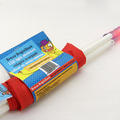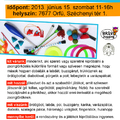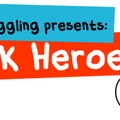| MAGYARUL |

 |
Tomás Di Tomaso astonished us by his many spectacular, dynamic-changing tricks based on grabing the devilstick. You can learn from him what the cardinal enemies of the juggler are, and that why it is good if you have a tangerine on the stage. |
Name: Tomás Di Tomaso
Age: 24
Nationality: Argentinian
Your job/school: Juggler
Place of living: Buenos Aires
How many years have you been juggling with sticks: 7 and a half years
Number of juggling sticks you have: 10
Other juggling equipments you play with: Clubs and balls
You mentioned that you are in Europe now. What are you doing here, what are your plans?
Nowadays I'm travelling in Italy with my bicycle. Right now in Firenze for a few days more and continuing in the trip. I'm carrying only my clothes, my tent and my devilsticks. I'll be performing in the streets or in different places presenting a new act that I'm rehearsing with a Miles Davis song.
Please write some sentences of yourself in general:
I'm a juggler from Buenos Aires, one of the biggest cities in South America where the art and the life are very near. Particullary I enjoyed to think that juggling is an artistic act that allows to prove that the impossible dreams can be possible. The jugglers are fighters against one of the unavoidable issues in life: gravity, and the jugglers that think in their acts as an artistic act are fighting also against death, and all jugglers should be proud of that. Also I collaborate with El Circense, a virtual circus magazine in Buenos Aires, that you can check in www.elcircense.com.
Why did you learn to use this juggling tool and where did you first meet with it?
I started using devilstick when I was 16 in the first juggling workshop I've been to, in a cultural space in Colegiales, my neighborhood in Buenos Aires. The teacher, Tamara, has brought all kind of juggling props and when I started playing devilstick I enjoyed a lot that. That was my first contact with the circus world.
Where did you learn playing with devilsticks?
I learned in different cultural spaces in Buenos Aires for free. There are many spaces where you can learn different art skills for free in the city. These spaces where opened after the last dictatorship with the idea of creating meeting points between the people in the city. This is a great idea because all kind of people of any social class can assist and learn anything in their own neighborhood for free.
I started in Colegiales and I continued with juggling classes in Centro Cultural Spilimbergo in another neighborhood where I met a lot of friends in this world.
What are you practicing at the moment?
I'm rehearsing a new act that I'll be presenting soon. It's an act of devilstick manipulation over a song of Miles Davis group. I think my juggling style has a lot of changing rythms so this is why it's very confortable for me to play with jazz music. That's the reason why I have chosen 'Teo' played by a beautiful line-up: Miles Davis, 'Cannonball' Aderley, John Coltrane, Bill Evans and more.
Do you have tricks that you found out?
Yes. In Buenos Aires there aren't a lot of jugglers that play devilstick, so there is no a lot of information to find. That's the reason why I love playing devilstick, because I had the urgent need to be creative -always with the help of my friends- for continuing with this prop. Most of the tricks I found out are the mix of club manipulation, contact and other games.
In what style do you play and what other styles do you like?
I think I love manipulation. Manipulation allows you to increase the possibilities of rythms, games and forms. The only rule is not to practise tricks that I don't like, so this way my juggling is really similar to the way I am. This is very interesting because I think there is a juggling style for each juggler. We need to find this out because it simplifies everyting in the road.
I enjoy a lot of juggling styles but I think club manipulation is the most I liked.
Where do you perform with devilsticks?
In Buenos Aires since the 90s there is an important underground movement that is an evolution of the underground theater -post dictatorship- in the 80s. This important underground movement has all kind of shows, including Circus Varietès in different spaces: cultural spaces, circus schools or little theaters.
There are varietès all weekends in different neighborhoods where coexist juggling, acrobatic and clown acts. Also in the last years the circus movement has increased the quantity of juggling conventions in Argentina.
I have performed in both kind of spaces. In varietès and in juggling conventions or circus festivals.
In an other video you walked among the audience and gave hugs to some people. Why did you do that? Is it a form of interaction?
I think improvisation in the scene and in the life is very important. I regulary performed with this improvisation rules: not to deny, not having pretensions and always playing for the other ones more than for myself. That night in the video there was some friends that are always near in this Varietes. Giving hugs was the first impulse I felt and is not only a form of interaction, it is also a reason to be surprised.
There is another act that I'm performing with. It's a game that consists in carrying to the scene my devilsticks and a plate with a tangerine. Each fall of the devilstick it leads to giving a part of the tangerine to the audience. The act finishes when there is no more tangerine. I really don't like when jugglers -with their falls or failing- make the audience suffer. Juggling -and art always- should be like a carnival in the life of the public. So with the tangerine there is no suffering, because there is another thing happening apart of the 'juggling game'. We are fighting against gravity but also against suffering.
Why a tangerine? There is a song of a popular artist -Maria Elena Walsh- that claims that in the autumm you don't have to be sad for the trees loosing their leaves. Instead of that, you have to enjoy the happiness for tasting the firsts tangerines. I think that's life.
What kind of sticks do you prefer to use?
I like long devilsticks and long handsticks. These measures help me for manipulating.
How is juggling life in Argentina? Are devilsticks popular?
Juggling is increasing a lot in Argentina. Since the 80s when some circus families opened the information to all people to now, there was an evolution incredible. There are a lot of juggling spaces and good jugglers playing all different kind of styles. Also there are a lot of juggling conventions and new circus festivals to perform all over the country: in Cordoba, Rio Cuarto, Mendoza, Rosario and also in different near countries as in Uruguay.
Devilsticks are not so popular. In the last Argentinian Circus Convention -the 14th- in the Devilstick workshop that I gave we were only 8 jugglers. The particularity is that the 8 of us played very different styles and with very different devilsticks. That is interesting. All the jugglers had the same information problem and this leads to create yourself the tricks, so it's wonderful. Having so much information sometimes makes more difficult to find yourself.
How do you imagine yourself being old? Will you still juggle?
Yes! I hope that I can still juggle with my juggler friends.
I can imagine playing different juggling games with Pablo Pramparo, an excellent juggler and friend of mine. We always talk about being old jugglers!
What do you advice to beginner/advanced stick players?
Enjoy the game. Enjoy everyting as in life. Playing is one of the greatest things in the world. And love what you do because this will give love to everyone that is watching you playing. Don't play for yourself... play for everyone and enjoy with everybody.
At last, don't worry if something goes wrong. There is always tangerine in autumm.
Bravo Juggling presents: Stick Heroes
July 2011 - Simon Oganisyan - Mr. Simon ▶
June 2011 - Tomás Di Tomaso ▶
May 2011 - Nikki Snijders ▶
April 2011 - Markus Furtner ▶
March 2011 - Adam Dipert ▶
February 2011 - Paul Rozaire - Polostick ▶
January 2011 - Alì Akbar Rahati Nover - Ghost ▶




